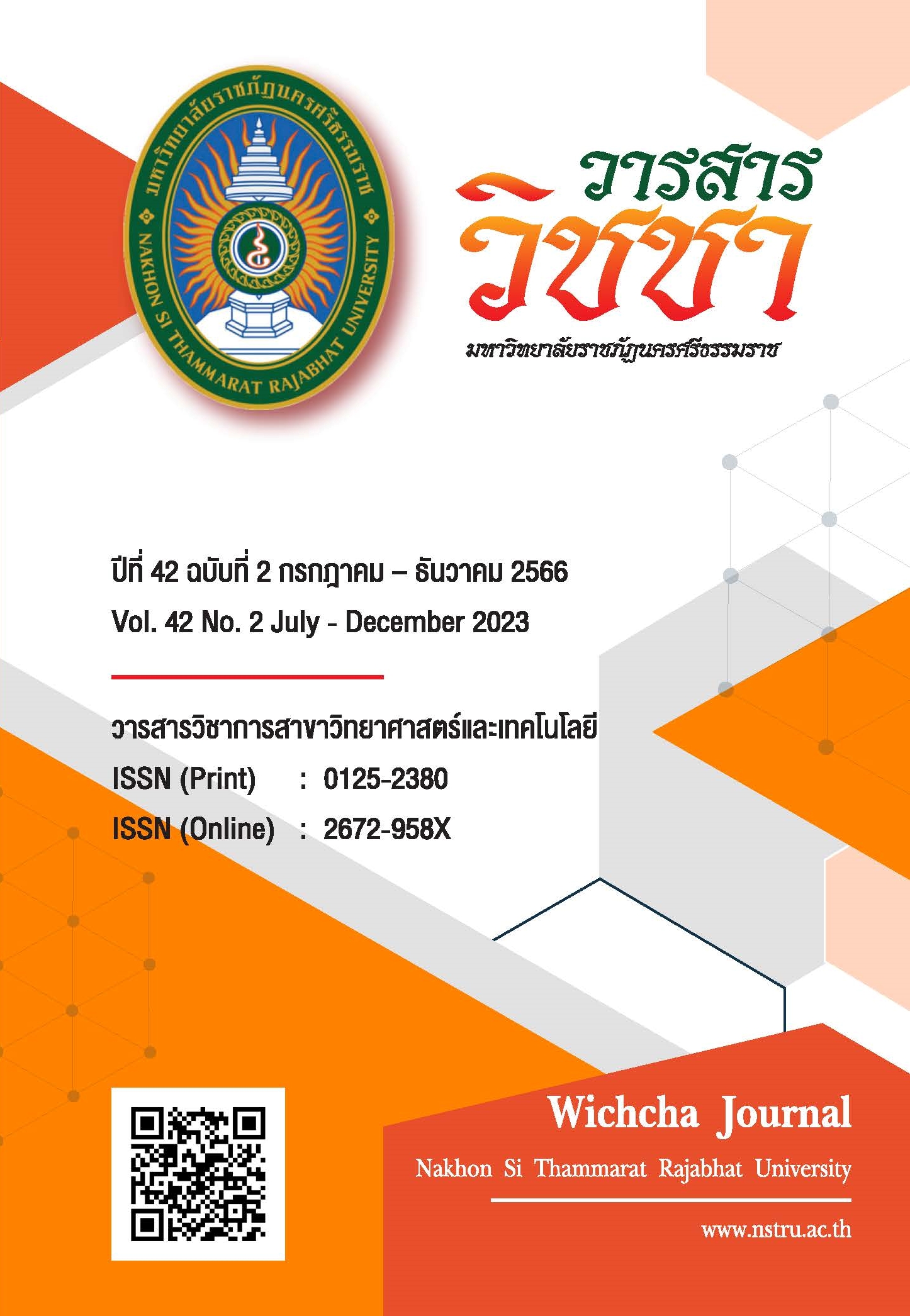The Study of In vitro Phagocytic Activity of Soybean Meal Fermented with Bacillus subtilis TISTR 2664
Main Article Content
Abstract
This study aimed to investigate the components and activity of bioactive peptides derived from Bacillus subtilis TISTR 2664 fermentation of soybean meal to stimulate phagocytosis. Soybean meal obtained from a soybean oil factory was used as a raw material for fermentation. It contained 44.65% protein, 1.28% oil, 5.54% dietary fiber, 12.08% moisture and 6.40% ash. When fermented with B. subtilis TISTR2664 and examined by SDS-PAGE, most of the protein size remained in the range of 5-29 kilo Dalton (kDa). The 8,981 types of peptides in the fermented soybean meal were investigated by Liquid Chromatography-Mass Spectrometry (LC-Q-TOF-MS/MS). Ten biologically active peptides having the following properties were predicted: anticancer, antifungal, antihypertensive antimicrobial antiparasitic anti-inflammatory antivirus cell communication, drug delivery, and tumor homing. Interestingly, the peptides with antihypertensive properties were found in the highest amounts. The results of this prediction will be useful for planning for further laboratory trials of the peptide derived from fermented soybean meal to lead to its utilization. A preliminary laboratory investigation into the toxicity of fermented soybean meal on RAW264.7 mouse macrophages was performed using the MTT assay. No cytotoxicity was observed at less than or equal to 25 milligrams per milliliters (mg/ml), with more than 70% viability of RAW264.7 cells. Moreover, sample concentrations ranging from 3.13 to 25 mg/ml were investigated. The results showed that at a 12.5% concentration, the highest phagocytic activity was induced at 93.27±0.50%, which was significantly higher than that of the positive control (p < 0.01). Nitric oxide production at 48.53±0.35 micromolar (µM) was non-significantly different from the positive control at all tested sample concentrations. The result of this study can be used as a guideline for fermented soybean meal research in immune stimulation for further development as a health supplement or as an added economic value.
Article Details

This work is licensed under a Creative Commons Attribution-NonCommercial-NoDerivatives 4.0 International License.
เนื้อหาและข้อมูลในบทความที่ลงตีพิมพ์ในวารสารวิชชา มหาวิทยาลัยราชภัฏนครศรีธรรมราช ถือเป็นข้อคิดเห็นและความรับผิดชอบของผู้เขียนบทความโดยตรง ซึ่งกองบรรณาธิการวารสารไม่จำเป็นต้องเห็นด้วยหรือร่วมรับผิดชอบใด ๆ
บทความ ข้อมูล เนื้อหา รูปภาพ ฯลฯ ที่ได้รับการตีพิมพ์ในวารสารวิชชา มหาวิทยาลัยราชภัฏนครศรีธรรมราช ถือเป็นลิขสิทธ์ของวารสารวิชชา มหาวิทยาลัยราชภัฏนครศรีธรรมราช หากบุคคลหรือหน่วยงานใดต้องการนำข้อมูลทั้งหมดหรือส่วนหนึ่งส่วนใดไปเผยแพร่ต่อหรือเพื่อการกระทำการใด ๆ จะต้องได้รับอนุญาตเป็นลายลักษณ์อักษรจากวารสารวิชชา มหาวิทยาลัยราชภัฏนครศรีธรรมราชก่อนเท่านั้น
The content and information in the article published in Wichcha journal Nakhon Si Thammarat Rajabhat University, It is the opinion and responsibility of the author of the article. The editorial journals do not need to agree. Or share any responsibility.
References
Castellano, P., Aristoy, M.C., Sentandreu, M.A., Vignolo, G. and Toldrá, F. (2013). Peptides with angiotensin I converting enzyme (ACE) inhibitory activity generated from porcine skeletal muscle proteins by the action of meat-borne Lactobacillus. Journal of Proteomics, 89, 183-190, doi: https://doi.org/10.1016/j.jprot.2013.06.023.
Chatterjee, C., Gleddie, S. and Xiao, C.W. (2018). Soybean bioactive peptides and their functional properties. Nutrients, 10(9), doi: https://doi.org/10.3390/nu10091211.
Coda, R., Rizzello, C.G., Pinto, D. and Gobbetti, M. (2012). Selected lactic acid bacteria synthesize antioxidant peptides during sourdough fermentation of cereal flours. Applied and Environmental Microbiology, 78(4), 1087-1096, doi: https://doi.org/10.1128/AEM.06837-11.
Escudero, E., Aristoy, M.C., Nishimura, H., Arihara, K. and Toldrá, F. (2012). Antihypertensive effect and antioxidant activity of peptide fractions extracted from Spanish dry-cured ham. Meat Science, 91(3), 306-311, doi: https://doi.org/10.1016/j.meatsci.2012.02.008.
International Standard (ISO 10993-5). (2009). Biological evaluation of medical devices-part 5: Tests for in vitro cytotoxicity. Geneva: International Organization for Standardization.
Karaki, H., Sugano, S., Uchiwa, H., Sugai, R., Murakami, U. and Takemoto, S. (1990). Antihypertensive effect of tryptic hydrolysate of milk casein in spontaneously hypertensive rats. Comparative Biochemistry and Physiology Part C: Comparative Pharmacology, 96(2), 367-371, doi: https://doi.org/10.1016/-8413(90)90023-3.
Korhonen, H. and Pihlanto, A. (2006). Bioactive peptides: Production and functionality. International Dairy Journal, 16(9), 945-960, doi: https://doi.org/10.1016/j.idairyj.2005.10.012.
Lowry, O.H., Rosebrough, N.J., Farr, A.L and Randall, R.J. (1951) Protein measurement with folin phenol reagent. The Journal of Biological Chemistry, 193, 265-275, doi: https://doi.org/10.1016/S0021-9258(19)52451-6.
Majumder, K. and Wu, J. (2014). Molecular targets of antihypertensive peptides: Understanding the mechanisms of action based on the pathophysiology of hypertension. International Journal of Molecular Sciences, 16(1), 256-283, doi: https://doi.org/10.3390/ijms16010256.
Medic, J., Atkinson, C. and Hurburgh, C.R. (2014). Current knowledge in soybean composition. Journal of the American Oil Chemists' Society, 91(3), 363-384, doi: https://doi.org/10.1007/s11746-013-2407-9.
Möller, N.P., Scholz-Ahrens, K.E., Roos, N. and Schrezenmeir, J. (2008). Bioactive peptides and proteins from foods: Indication for health effects. European Journal of Nutrition, 47(4), 171-182, doi: https://doi.org/10.1007/s00394-008-0710-2.
Singh, B.P., Aluko, R.E., Hati, S. and Solanki, D. (2022). Bioactive peptides in the management of lifestyle-related diseases: Current trends and future perspectives. Critical Reviews in Food Science and Nutrition, 62(17), 4593-4606, doi: https://doi.org/10.1080/10408398.2021.1877109.
Tachapuripunya, V., Roytrakul, S., Chumnanpuen, P. and E-kobon, T. (2021). Unveiling putative functions of mucus proteins and their tryptic peptides in seven gastropod species using comparative proteomics and machine learning-based bioinformatics predictions. Molecule, 26(11), doi: https://doi.org/10.3390/molecules26113475.
Wen, L., Bi, H., Zhou, X., Zhu, H., Jiang, Y., Ramadan, N.S. and Yang, B. (2022). Structure and activity of bioactive peptides produced from soybean proteins by enzymatic hydrolysis. Food Chemistry Advances, 1, doi: https://doi.org/10.1016/j.focha.2022.100089.
Yoshikawa, M. (2015). Bioactive peptides derived from natural proteins with respect to diversity of their receptors and physiological effects. Peptides, 72, 208-225, doi: https://doi.org/10.1016/j.peptides.2015.07.013.
Yuan, L., Chang, J., Yin, Q., Lu, M., Di, Y., Wang, P. and Lu, F. (2017). Fermented soybean meal improves the growth performance, nutrient digestibility, and microbial flora in piglets. Animal Nutrition, 3(1), 19-24, doi: https://doi.org/10.1016/j.aninu.2016.11.003.
Zhang, Y., Chen, S., Zong, X., Wang, C., Shi, C., Wang, F. and Lu, Z. (2020). Peptides derived from fermented soybean meal suppresses intestinal inflammation and enhances epithelial barrier function in piglets. Food and Agricultural Immunology, 31(1), 120-135, doi: https://doi.org/10.1080/09540105.2019.1705766.
Zhang, Z., Hu, X., Lin, L., Ding, G. and Yu, F. (2019). Immunomodulatory activity of low molecular-weight peptides from Nibea japonica in RAW264.7 cells via NF-κB pathway. Marine Drugs, 17(7), doi: https://doi.org/10.3390/md17070404.


